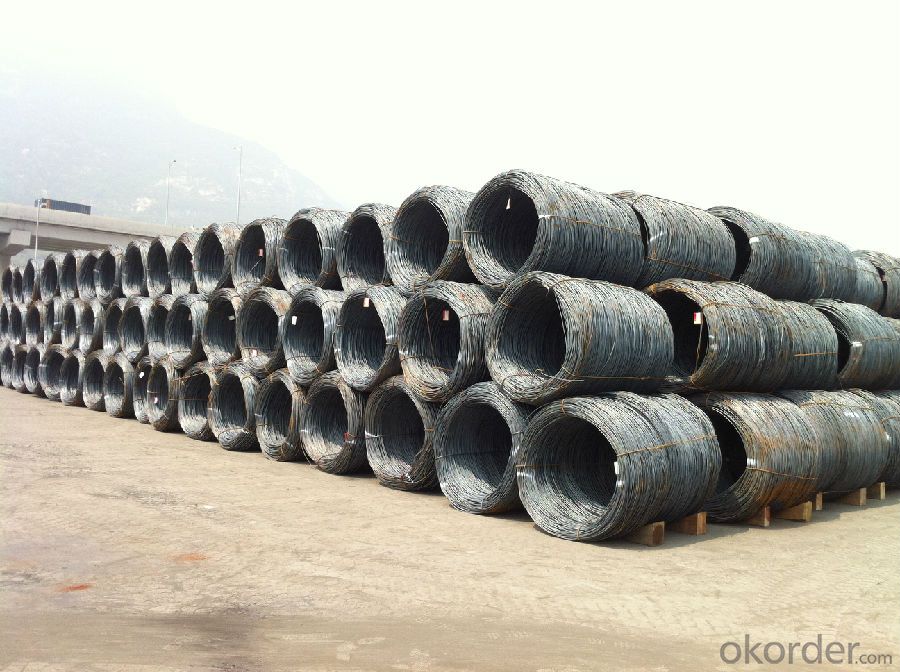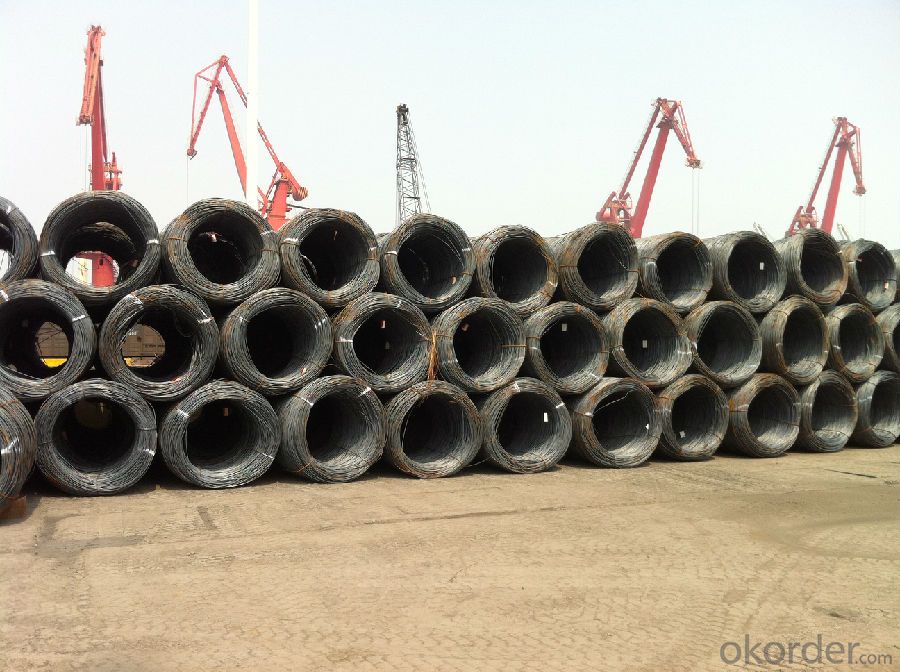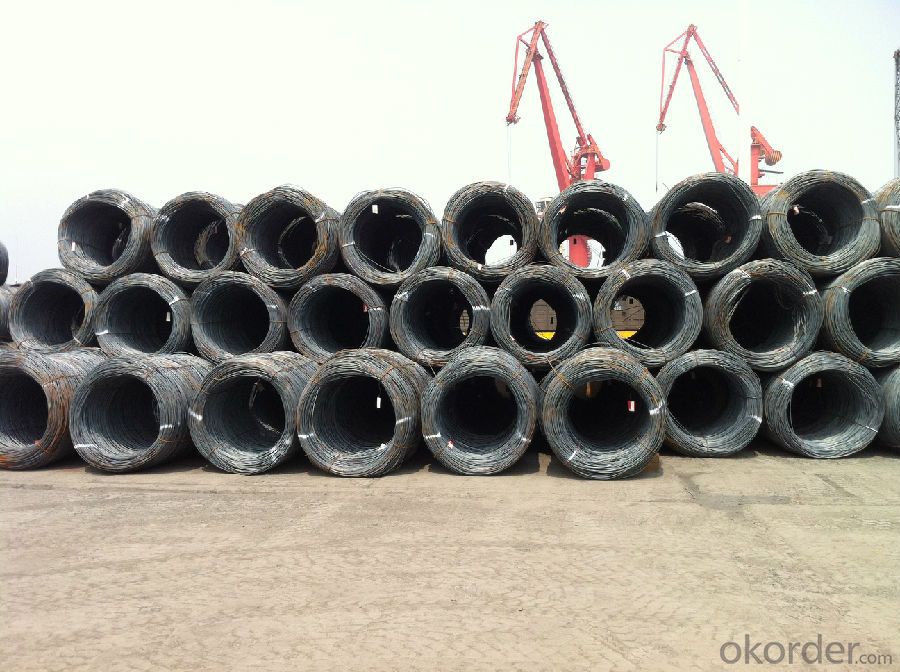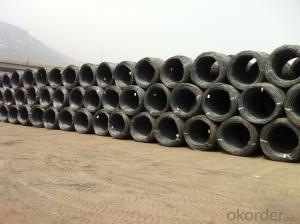Wire rods With High quality and Best Price
- Loading Port:
- Tianjin
- Payment Terms:
- TT OR LC
- Min Order Qty:
- 25 m.t.
- Supply Capability:
- 20000 m.t./month
OKorder Service Pledge
OKorder Financial Service
You Might Also Like
OKorder is offering high quality Hot Rolled Wire Rods at great prices with worldwide shipping. Our supplier is a world-class manufacturer of steel, with our products utilized the world over. OKorder annually supplies products to European, North American and Asian markets. We provide quotations within 24 hours of receiving an inquiry and guarantee competitive prices.
Product Applications:
Hot Rolled Wire Rods are ideal for structural applications and are widely used in the construction of buildings and the manufacturing, industries.
Product Advantages:
OKorder's Wire Rods are durable, strong, and resist corrosion.
Main Product Features:
· Premium quality
· Prompt delivery & seaworthy packing (30 days after receiving deposit)
· Corrosion resistance
· Can be recycled and reused
· Mill test certification
· Professional Service
· Competitive pricing
Product Specifications:
Manufacture: Hot rolled
Grade: SAE1006 – SAE1008
Certificates: ISO, SGS, BV, CIQ
Length: 6m – 12m, as per customer request
Packaging: Export packing, nude packing, bundled
Grade | Chemical Composition (%) | |||||
C | Mn | S | P | Si | B | |
SAE1006B | 0.03~O.07 | 0.32max | 0.045max | 0.040max | 0.30max | 0.0008min |
Mechanical properties | ||||||
Yield strength(N/mm2) | Tensile strength(N/mm2) | Elongation (%) | ||||
250-280 | 350-380 | ≥32 | ||||
Grade | Chemical Composition (%) | |||||
C | Mn | S | P | Si | B | |
SAE1008B | 0.10max | 0.3~0.50 | 0.050max | 0.040 max | 0.15max | 0.0008 min |
Mechanical properties | ||||||
Yield strength(N/mm2) | Tensile strength(N/mm2) | Elongation (%) | ||||
≥195 | 315-430 | ≥30 | ||||
FAQ:
Q1: Why buy Materials & Equipment from OKorder.com?
A1: All products offered byOKorder.com are carefully selected from China's most reliable manufacturing enterprises. Through its ISO certifications, OKorder.com adheres to the highest standards and a commitment to supply chain safety and customer satisfaction.
Q2: How do we guarantee the quality of our products?
A2: We have established an advanced quality management system which conducts strict quality tests at every step, from raw materials to the final product. At the same time, we provide extensive follow-up service assurances as required.
Q3: Can stainless steel rust?
A3: Stainless does not "rust" as you think of regular steel rusting with a red oxide on the surface that flakes off. If you see red rust it is probably due to some iron particles that have contaminated the surface of the stainless steel and it is these iron particles that are rusting. Look at the source of the rusting and see if you can remove it from the surface.
Images:



- Q:What are the main factors influencing the choice of steel wire rod order quantity?
- The main factors influencing the choice of steel wire rod order quantity include market demand, production capacity, lead time, inventory holding costs, and pricing dynamics. Firstly, market demand plays a crucial role in determining the order quantity of steel wire rods. Companies need to assess the current and future demand trends in their target markets to ensure they meet customer requirements without overstocking or facing shortages. Accurate demand forecasting is essential to optimize the order quantity. Secondly, the production capacity of the supplier or manufacturer is a critical factor in determining the order quantity. Companies need to evaluate the supplier's capabilities to meet their required quantity within the desired timeframe. If the supplier has limited production capacity, it may impact the order quantity decision. Lead time, which refers to the time taken from placing an order to receiving the goods, is another influential factor. Longer lead times may require companies to order larger quantities to ensure an uninterrupted supply chain. Conversely, shorter lead times may allow for smaller order quantities, reducing inventory carrying costs. Inventory holding costs comprise expenses associated with storing and managing inventory. Companies need to consider these costs while deciding the order quantity. Ordering excessive quantities may lead to higher holding costs, including storage, insurance, and obsolescence, while ordering insufficient quantities may result in stockouts and potentially lost sales. Lastly, pricing dynamics can influence the order quantity of steel wire rods. Bulk purchasing often leads to better pricing terms, discounts, or rebates. Therefore, companies may consider ordering larger quantities to take advantage of favorable pricing conditions. However, they must carefully evaluate the trade-off between potential cost savings and inventory carrying costs. In conclusion, the main factors influencing the choice of steel wire rod order quantity are market demand, production capacity, lead time, inventory holding costs, and pricing dynamics. By considering these factors, companies can optimize their order quantity decisions to ensure an efficient supply chain and meet customer requirements effectively.
- Q:What are the potential drawbacks of using steel wire rod?
- Some potential drawbacks of using steel wire rod include its susceptibility to corrosion if not properly coated, its relatively high cost compared to other materials like aluminum or plastic, and its limited flexibility and maneuverability compared to other wire materials. Additionally, steel wire rod may be heavier and bulkier, making it less suitable for certain applications that require lightweight or compact solutions.
- Q:What are the common storage methods for steel wire rod?
- The common storage methods for steel wire rod include coil storage, bundle storage, and rack storage.
- Q:Can steel wire rod be used in the production of wire ropes?
- Yes, steel wire rod can be used in the production of wire ropes. Wire ropes are typically made by twisting multiple strands of steel wires together to form a strong and flexible rope. Steel wire rod is often used as the raw material for manufacturing these wires, as it possesses the necessary strength and durability required for wire rope production.
- Q:How are steel wire rods stored to prevent corrosion?
- Steel wire rods are typically stored in a controlled environment, such as a warehouse, where proper temperature and humidity levels are maintained. They are often coated with a protective layer, such as rust-inhibiting oil or a corrosion-resistant coating, to prevent direct contact with moisture. Additionally, steel wire rods may be stored on pallets or racks, ensuring they are kept off the ground and away from any potential sources of moisture. Regular inspections and maintenance are also conducted to identify and address any signs of corrosion promptly.
- Q:What are the different types of steel wire rod surface cleaning methods for wire galvanizing?
- There are several different types of steel wire rod surface cleaning methods that can be used for wire galvanizing. These methods are designed to remove any impurities or contaminants from the surface of the wire rod before it undergoes the galvanizing process. One common method is acid pickling. Acid pickling involves immersing the wire rod in a bath of acid solution, usually hydrochloric acid or sulfuric acid. The acid helps to dissolve any mill scale, rust, or other surface contaminants, leaving the wire rod clean and ready for galvanizing. Another method is mechanical descaling. This method involves using mechanical means, such as abrasive brushes or shot blasting, to physically remove any surface impurities from the wire rod. This method is often used for wire rods that have heavy scale or stubborn contaminants that cannot be easily removed by acid pickling alone. Additionally, there is a method called electrolytic cleaning. This method uses an electric current to remove surface impurities from the wire rod. The wire rod is immersed in an electrolyte solution, and an electric current is passed through the solution, causing the impurities to migrate away from the wire rod and towards the opposite electrode. This method is often used for wire rods that have a thin layer of oxide or other surface contaminants. Finally, there is a method called mechanical cleaning. This method involves using mechanical means, such as wire brushing or sanding, to physically scrub the surface of the wire rod and remove any surface impurities. This method is often used for wire rods that have light scale or surface contaminants that can be easily removed by mechanical means. Overall, the choice of cleaning method will depend on the specific requirements and condition of the wire rod. Each method has its own advantages and disadvantages in terms of effectiveness, cost, and environmental impact.
- Q:What are the different types of steel wire rod annealing atmospheres?
- The different types of steel wire rod annealing atmospheres include hydrogen, nitrogen, and endothermic gas.
- Q:How is steel wire rod used in the manufacturing of wire forms for automotive seating?
- The manufacturing process of wire forms for automotive seating heavily relies on steel wire rod. Wire forms, which are widely employed in automotive seats to enhance comfort and provide structural support, require steel wire rod as their essential component. To begin with, the main framework of the wire forms is produced using steel wire rod. These wire forms function as the seat's skeleton, ensuring a durable structure capable of withstanding the weight and movements of passengers. Typically, the wire rod is bent, shaped, and welded together to achieve the desired shape of the wire form. Furthermore, the creation of springs used in automotive seating heavily relies on steel wire rod. These springs are responsible for providing cushioning and support, guaranteeing a comfortable and ergonomic experience for passengers. Depending on the specific seat design requirements, the wire rod is coiled into springs of various shapes and sizes. Moreover, steel wire rod is essential in the manufacturing of seat frames. These frames serve the purpose of securely holding the seat's various components, including foam padding and upholstery. The wire rod is frequently employed in constructing the frame structure, ensuring the necessary strength and durability to withstand daily use and impact. In conclusion, the utilization of steel wire rod is of utmost importance in the manufacturing process of wire forms for automotive seating. It is crucial for creating the main framework, springs, and seat frames, ultimately resulting in structurally sound, comfortable, and long-lasting seats.
- Q:How is steel wire rod used in the manufacturing of wire forms for display racks?
- The manufacturing of wire forms for display racks heavily relies on steel wire rod. This component plays a vital role as the raw material that is subjected to a range of manufacturing processes in order to create wire forms with precise shapes and sizes. The initial step involves carefully selecting the appropriate quality and diameter of steel wire rod. This selection process is dependent on the desired strength, durability, and flexibility of the wire forms. Once the suitable steel wire rod has been chosen, it is fed into a wire drawing machine. In this machine, the steel wire rod is pulled through a series of dies, effectively reducing its diameter and increasing its length. Once the wire has been successfully drawn to the desired size, it proceeds to undergo a series of shaping and bending processes. These processes may entail the utilization of specialized machines or tools to bend the wire into specific angles, curves, or shapes that are required for the display racks. Additionally, the wire may also be cut into specific lengths as per the design requirements. In order to retain the desired shape and structure of the wire forms, further processes such as heat treatment or galvanization may be carried out. Heat treatment serves to strengthen the wire forms, making them more resistant to bending or deforming when subjected to heavy loads. On the other hand, galvanization entails applying a protective layer of zinc onto the wire forms to safeguard against corrosion, thereby enhancing their lifespan. Once the wire forms have been shaped, bent, and treated, they are now ready to be assembled into the display racks. These wire forms can be employed for various purposes within the display rack industry, such as forming shelves, hooks, or frames. The versatility of steel wire rod allows for the production of wire forms in different designs, sizes, and load capacities, thus enabling them to meet the specific requirements of display rack applications. To summarize, the manufacturing process of wire forms for display racks heavily relies on steel wire rod. This crucial component undergoes a range of processes including wire drawing, shaping, bending, and treatment to produce wire forms with specific shapes, sizes, strength, and durability. Once assembled into display racks, these wire forms provide a robust and adaptable solution for showcasing products.
- Q:How is steel wire rod recycled at the end of its lifecycle?
- Steel wire rod can undergo steel scrap recycling at the end of its lifecycle. This involves a number of steps to transform the wire rod into reusable steel materials. To begin the recycling process, steel wire rod scraps are collected from various sources such as manufacturing waste, construction materials, or end-of-life products like old cars or appliances. Once collected, the scraps are sorted and separated based on their composition and quality. The sorted steel wire rod scraps are then sent to a recycling facility where they are shredded into smaller pieces to facilitate further processing. Shredding can be done using different methods, such as hydraulic shears or industrial shredders. After shredding, the steel wire rod pieces undergo magnetic separation to remove any non-ferrous materials like plastic or rubber that may be mixed with the scraps. Magnetic separators attract and remove these non-ferrous materials, leaving behind the steel wire rod pieces. The separated steel wire rod pieces are further processed to remove impurities or contaminants. This is done through a process called melting, where the wire rod pieces are heated to extremely high temperatures in a furnace. This melting process burns off or skims off any impurities or contaminants from the molten metal. Once the impurities are removed, the molten steel is poured into molds to form new steel products. The molds can vary depending on the desired shape and size of the final product. After the steel has solidified, it can be further processed and treated to meet specific requirements, such as tempering or strengthening. The recycled steel wire rod can be used as raw material in industries like construction, automotive manufacturing, and appliance production. This reduces the need for extracting and refining virgin iron ore, which conserves natural resources and minimizes environmental impact. In conclusion, steel wire rod is recycled through a series of steps including collection, sorting, shredding, magnetic separation, melting, molding, and further processing. This process allows the steel to be reused in various industries, promoting sustainability and reducing the demand for new steel production.
1. Manufacturer Overview |
|
|---|---|
| Location | |
| Year Established | |
| Annual Output Value | |
| Main Markets | |
| Company Certifications | |
2. Manufacturer Certificates |
|
|---|---|
| a) Certification Name | |
| Range | |
| Reference | |
| Validity Period | |
3. Manufacturer Capability |
|
|---|---|
| a)Trade Capacity | |
| Nearest Port | |
| Export Percentage | |
| No.of Employees in Trade Department | |
| Language Spoken: | |
| b)Factory Information | |
| Factory Size: | |
| No. of Production Lines | |
| Contract Manufacturing | |
| Product Price Range | |
Send your message to us
Wire rods With High quality and Best Price
- Loading Port:
- Tianjin
- Payment Terms:
- TT OR LC
- Min Order Qty:
- 25 m.t.
- Supply Capability:
- 20000 m.t./month
OKorder Service Pledge
OKorder Financial Service
Similar products
New products
Hot products
Related keywords


























